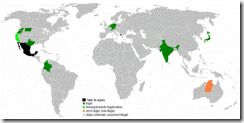Euthanasia
(one sentence meaning ; For mercy killings, onekind: asistent suicide)
refers to the practice of ending a life in a manner which relieves pain and suffering. According to the House of Lords Select Committee on Medical Ethics, the precise definition of euthanasia is "a deliberate intervention undertaken with the express intention of ending a life, to relieve intractable suffering."[1]
Euthanasia is categorized in different ways, which include voluntary, non-voluntary, or involuntary and active or passive. Euthanasia is usually used to refer to active euthanasia, and in this sense, euthanasia is usually considered to be criminal homicide, but voluntary, passive euthanasia is widely non-criminal.
The controversy surrounding euthanasia centers around a two-pronged argument by opponents which characterizes euthanasia as either voluntary "suicides", or as involuntary murders. (Hence, opponents argue that a broad policy of "euthanasia" is tantamount to eugenics). Much hinges on whether a particular death was considered an "easy", "painless", or "happy" one, or whether it was a "wrongful death". Proponents typically consider a death that increased suffering to be "wrongful", while opponents typically consider any deliberate death as "wrongful". "Euthanasia's" original meaning introduced the idea of a "rightful death" beyond that only found in natural deaths.
Euthanasia is the most active area of research in contemporary bioethics.[2]
Classification of euthanasia
Euthanasia may be classified according to whether a person gives informed consent into three types: voluntary, non-voluntary and involuntary.[5][6]
There is a debate within the medical and bioethics literature about whether or not the non-voluntary (and by extension, involuntary) killing of patients can be regarded as euthanasia, irrespective of intent or the patient's circumstances. In the definitions offered by Beauchamp & Davidson and, later, by Wreen, consent on the part of the patient was not considered to be one of their criteria.[7][8] However, others see consent as essential. For example, in a discussion of euthanasia presented in 2003 by the European Association of Palliative Care (EPAC) Ethics Task Force, the authors offered the unambiguous statement:
Medicalized killing of a person without the person's consent, whether nonvoluntary (where the person in unable to consent) or involuntary (against the person's will) is not euthanasia: it is murder. Hence, euthanasia can be voluntary only.[9]
Voluntary euthanasia
Main article: Voluntary euthanasia
Euthanasia conducted with the consent of the patient is termed voluntary euthanasia. Active voluntary euthanasia is legal in
Non-voluntary euthanasia
Main article: Non-voluntary euthanasia
Euthanasia conducted where the consent of the patient is unavailable is termed non-voluntary euthanasia. Examples include child euthanasia, which is illegal worldwide but decriminalised under certain specific circumstances in the
Involuntary euthanasia
Main article: Involuntary euthanasia
Euthanasia conducted against the will of the patient is termed involuntary euthanasia.
Procedural decision
Voluntary, non-voluntary and involuntary euthanasia can all be further divided into passive or active variants.[10] A number of authors consider these terms to be misleading and unhelpful.[1]
Passive euthanasia
Passive euthanasia entails the withholding of common treatments, such as antibiotics, necessary for the continuance of life.[1]
Active euthanasia
Active euthanasia entails the use of lethal substances or forces to kill and is the most controversial means.
Legal status
Map of the legality of euthanasia.
Main article: Legality of euthanasia
West's Encyclopedia of American Law states that "a 'mercy killing' or euthanasia is generally considered to be a criminal homicide"[11] and is normally used as a synonym of homicide committed at a request made by the patient.[12]
The judicial sense of the term "homicide" includes any intervention undertaken with the express intention of ending a life, even to relieve intractable suffering.[12][13][14] Not all homicide is unlawful.[15] Two designations of homicide that carry no criminal punishment are justifiable and excusable homicide.[15] In most countries this is not the status of euthanasia. The term "euthanasia" is usually confined to the active variety; the
Some governments around the world have legalized voluntary euthanasia but generally it remains as a criminal homicide. In the
